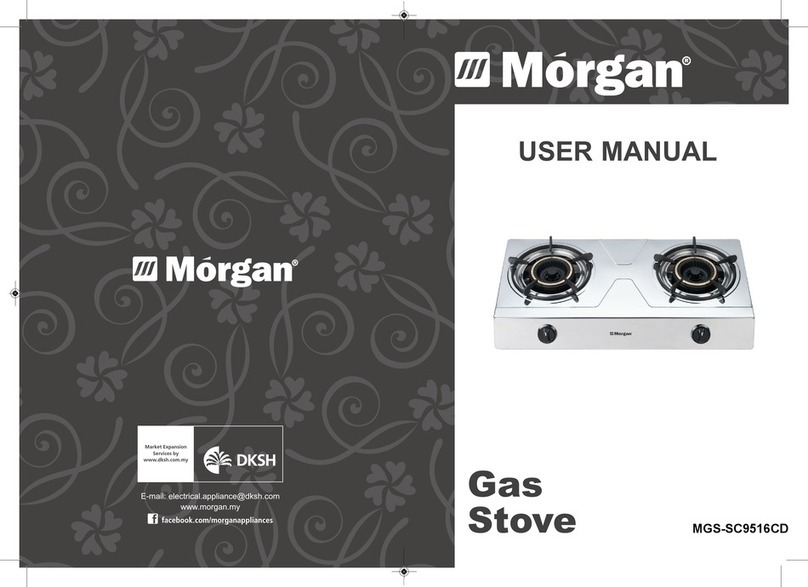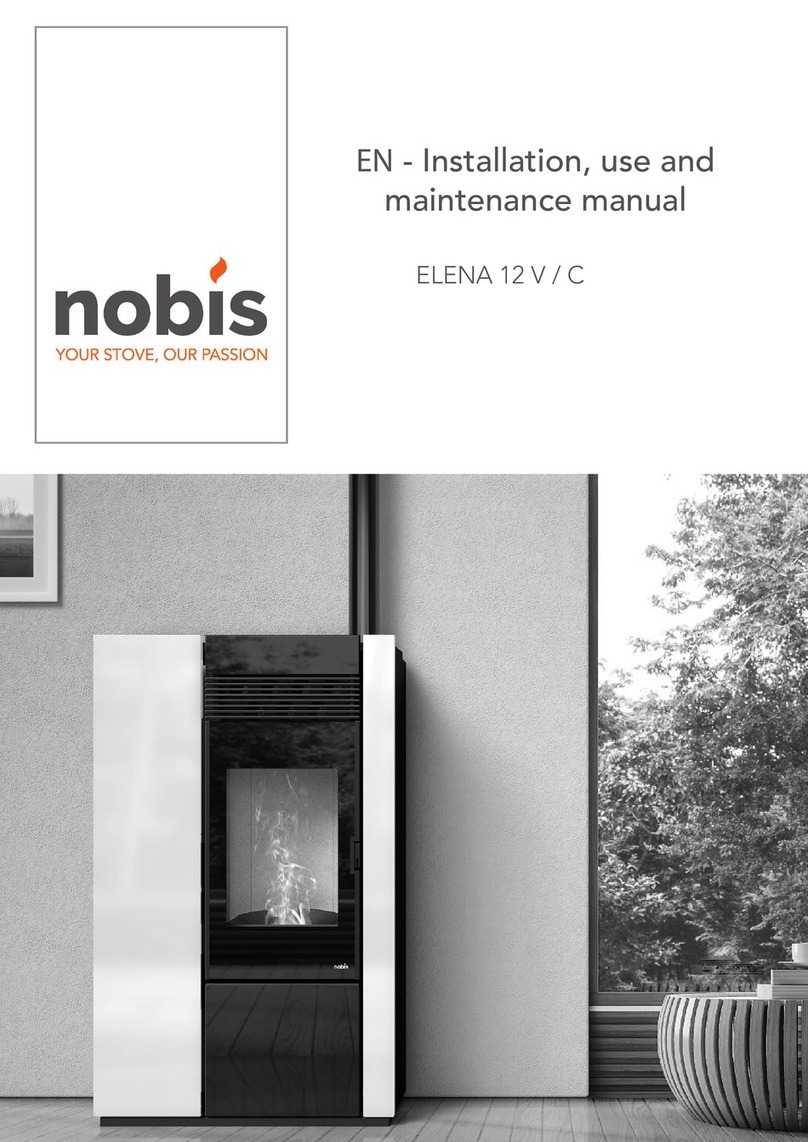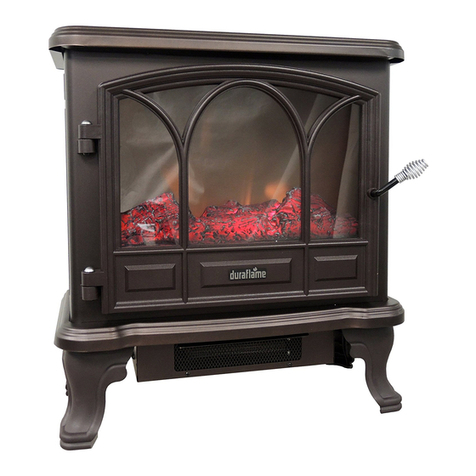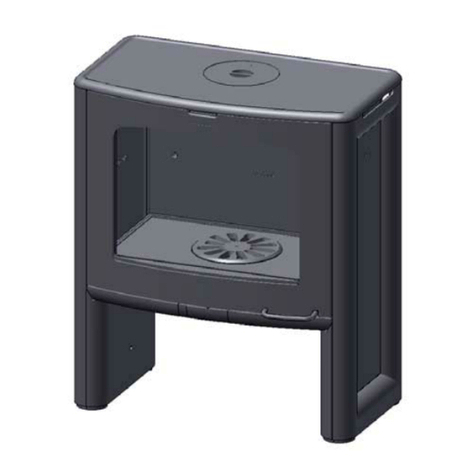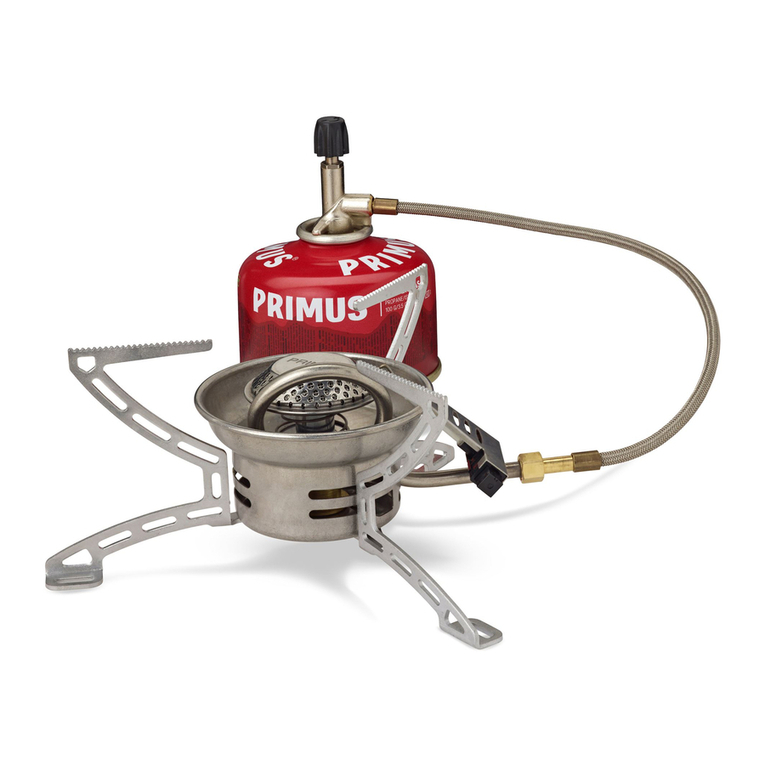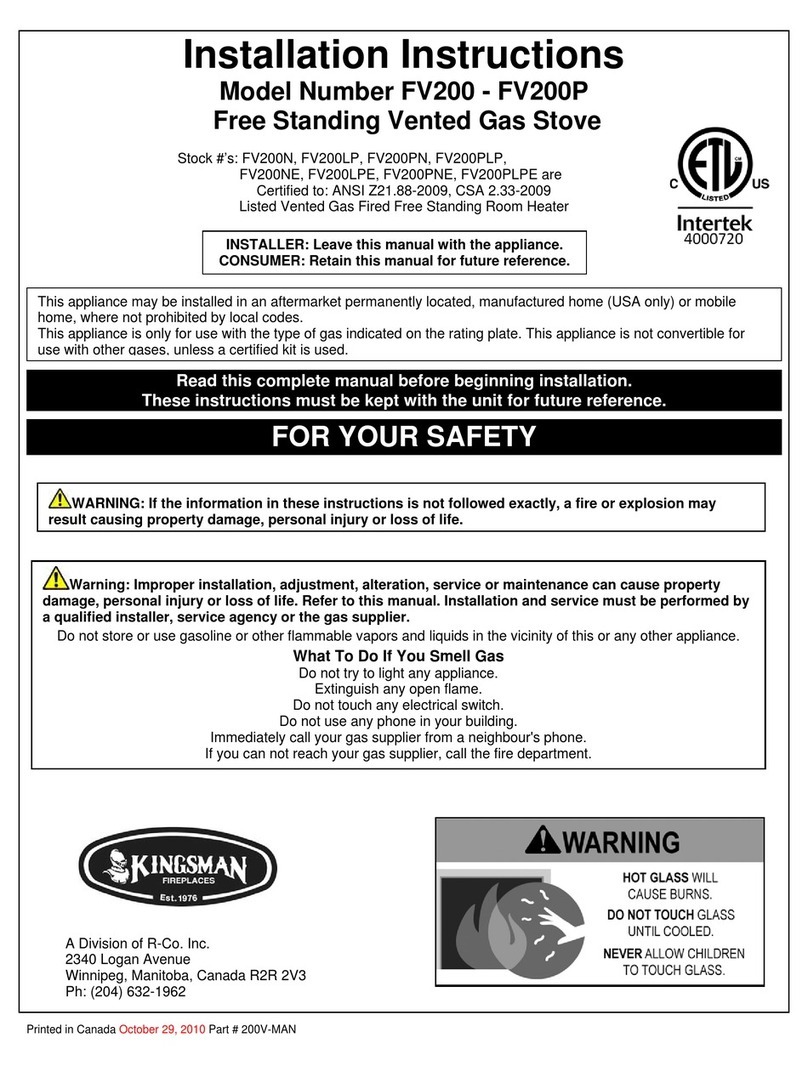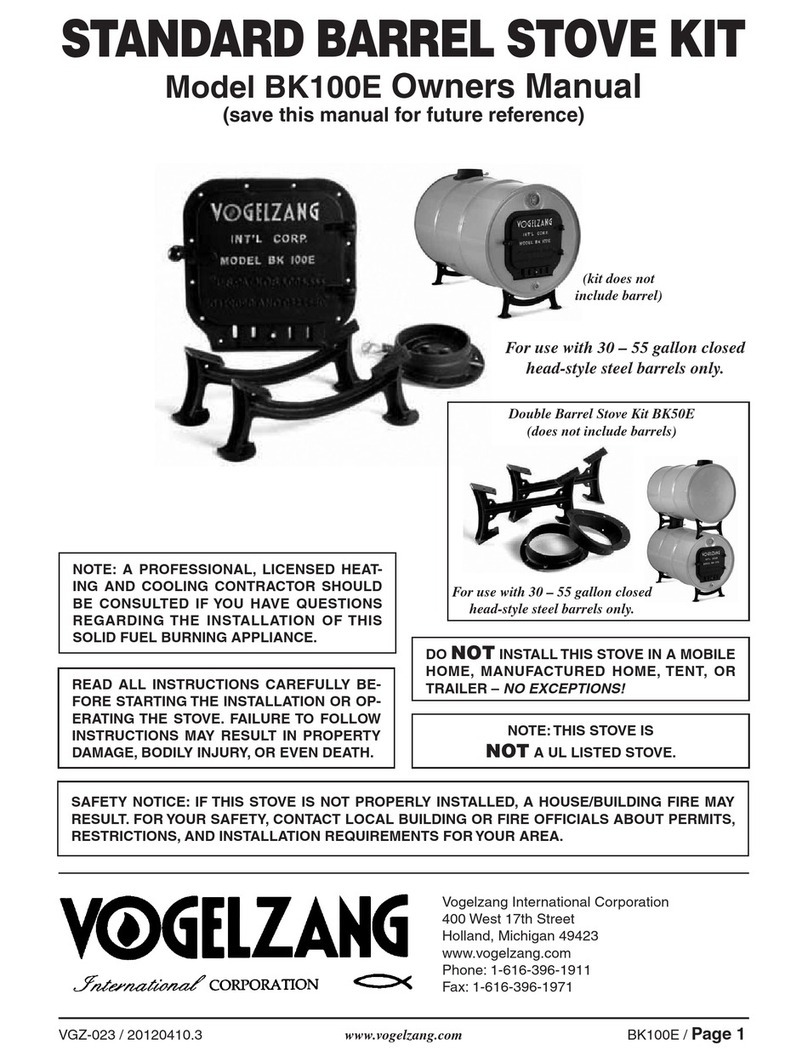Dean Stoves 105SE User manual

1
Dean Stoves
Dean Forge Fabrication Ltd. Dean Prior, Buckfastleigh, Devon TQ11 0LS
T e l: 0 1 3 6 4 6 4 3 5 7 4
w w w.d e a n–f o r g e.c o.u k e m a i l: s t o v e s @ d e a n-f o r g e.c o.u k
Operating Instructions for the Dean Stoves 105SE Inset
(105IS issue1st October 2016)
All stoves meet the essential type test requirement
BS EN13229:2001 + A1:2003 +A2:2004, CE marked
The 105Se inset is Ecodesign ready and satisfies all the stringent
emission requirements.
The Clean Air Act 1993 and Smoke Control Areas
Under the Clean Air Act local authorities may declare the whole or part of the district of the
authority to be a smoke control area. It is an offence to emit smoke from a chimney of a
building, from a furnace or from any fixed boiler if located in a designated smoke control area.
It is also an offence to acquire an "unauthorised fuel" for use within a smoke control area
unless it is used in an "exempt" appliance ("exempted" from the controls which generally apply
in the smoke control area).
The Secretary of State for Environment, Food and Rural Affairs has powers under the Act to
authorise smokeless fuels or exempt appliances for use in smoke control areas in England. In
Scotland and Wales this power rests with Ministers in the devolved administrations for those
countries. Separate legislation, the Clean Air (Northern Ireland) Order 1981, applies in
Northern Ireland. Therefore it is a requirement that fuels burnt or obtained for use in smoke
control areas have been "authorised" in Regulations and that appliances used to burn solid
fuel in those areas (other than "authorised" fuels) have been exempted by an Order made and
signed by the Secretary of State or Minister in the devolved administrations.
The Dean Stoves, 105Se inset has been recommended as suitable for use in smoke control
areas when burning wood logs.
To use the 105Se inset in smoke controlled areas the smoke control kit must be fitted to the
stove.
Further information on the requirements of the Clean Air Act can be found here:
http://smokecontrol.defra.gov.uk/
Your local authority is responsible for implementing the Clean Air Act 1993 including
designation and supervision of smoke control areas and you can contact them for details of
Clean Air Act requirements
Important
You will find a rectangular shaped plate with slotted holes in it, situated on the top of the main
grate. This grate is design to retain the ash when burning wood only and must NOT be used
when burning solid fuel (smokeless fuel or similar) or a mixture of wood and solid fuel. This
plate can be lifted out prior to lighting the fire, if required. Although the stove will burn wood
straight on the solid fuel grate, the rectangular shaped plate retains the ash and helps to give a
slower and hotter burn. By using the suppled tool/poker the ash can be pushed backwards and
forwards which will help it drop through to the ash pan. Always leave a small layer of ash on
the plate.

2
Unpacking Stove
Remove all packaging and stickers, Check the protective brick lining and the baffle plate has
not moved in transit. Remove the glove pack and operating tool from the inside of the stove.
Safety Note
Warning- The external parts of the appliance will get very hot to the touch and due care will
be needed when operating.
All stoves before being operated must be checked that the installation complies with all local,
national and European standards.
Before the stove is first used or when fitting other appliances into the room, please check that
adequate air vents are in place to cover the requirements of such appliances.
Extractor Fans. Do not use an extractor fan in the same room when operating a stove.
Wood & Suitable fuels
Dry wood, 18% moisture content or below must be used or the stove and flue will tar up
and the door won’t stay clean.
Wood is best seasoned by splitting it into a log and dried for 2 years in a covered area allowing
air to pass through.
When used as a Multi Fuel, use only smokeless fuels recommended for enclosed
appliances.
Please Note: Appliances should not be used as general incinerators or with non-recommended
fuels.
At no time should liquid accelerants i.e: Paraffin, Petrol, BBQ lighting liquid etc.be used.
The chimney needs to be swept at least once a year.
Maximum Log Length
Maximum Log Diameter
250mm
100mm

3
Door Operation
The door handle can become very hot so use the glove provided.
Handle:- When closed the door handle will be pointing down and straight with the door.
Twist the door handle about ¼ of a turn anti –clockwise to open the door.
Controlling the stove
Diagram A:
Primary and secondary air controls situated below the door
Primary = A
Secondary = B
The primary air control is indicated with a single ring turned into the control knob. This control
is used for lighting the fire or boosting the fire. This is also the main control when burning
solid fuel. Pull fully out for maximum air flow to the fire and fully in to close the air flow.
The secondary air wash control is indicated with double ring turned into the control knob. This
controls the preheated air wash system. Once the fire in the stove is established this is the
control that should be used to control the fire when burning wood.
The secondary control works as follows:
Pull out fully for maximum air flow into the fire and fully in for minimum airflow to the fire.
Once a fire is established push the secondary air control in until required flame pattern is
achieved, approximately 75% closed. When operating at the low output setting (with the
DEFRA stop fitted) it is necessary to leave the door ajar for a period of 1 –2 minutes in order
to sustain flames on the newly charged fuel. The appliance must not be operated with the air
controls or door left open except as directed in the instructions.

4
Lighting The Stove When Using Wood
Lay a fire of sticks and paper. Firelighters can be used if necessary. Check the secondary air
lever is fully open and the primary air is partially open. Light the fire and as the fire catches
the paper you may then fully open the primary air vents.
When the fire has fully established and the logs are burning well shut the primary air vent and
control the fire with the secondary air wash lever (if you are unable to sustain the fire with
secondary control it is very likely that your logs have a high moisture content).
Refuelling
When refuelling the fire, to ensure clean burning, the primary air control should be opened for
a couple of minutes so that flames are established on the newly fuelled logs. The primary air
(A) should then be closed (pushed fully in) and the secondary air (B) adjusted to create the
desired flame pattern once these flames are established and the logs have become blackened.
After refuelling, it is recommended that you do not leave the appliance unattended until it is
certain that the logs are burning well with a sustained flame.
Do not load the fuel above the log retainer.
Please note:
If there is insufficient burning material in the fire bed to light a new fuel charge, excessive
smoke emission can occur. Refuelling must be carried out onto a sufficient quantity of glowing
embers and ash that the new fuel charge will ignite in a reasonable period. If there are too few
embers in the fire bed, add suitable kindling to prevent excessive smoke.
Fuel overloading
The maximum amount of fuel specified in this manual should not be exceeded, overloading
can cause excess smoke.
The door should always be closed between refuelling to prevent fumes and spillage from the
firebox.
When loading the fire be careful not to leave logs projecting over the log retainer as you may
crack the glass when closing the door.
The ash should be emptied before it reaches the top of the ash pan to prevent ash dropping into
the primary air ducts. To remove the ash pan, use the tool provided. The tool has a protruding
ridge which fits under the lip in the ash pan, as shown below.

5
Warning: The ash pan and content can be hot and must be stored in a non-flammable
container away from flammable material then disposed of only when they are completely
cold and there is no risk of causing a fire.
.
Lighting The Stove With Solid Fuel
Remove the rectangular shaped woodburning plate if in place.
Lay a fire of sticks and paper, establish the fire and then add the appropriate smokeless fuel
and use the primary air control as the main control. If using a mixture of wood and coal,
balance the primary and secondary control to achieve the desired fire.
When using solid fuel in this stove you must only use fuels recommended for enclosed
appliances, Oil derivative fuels must not be used as this will shorten the life of the grate.
The ash pan will need emptying once a day.
The stove will work best using the primary air control. It is unlikely you will need to use the
secondary air control which will only need to be opened slightly to keep the glass clear. With
suitable adjustment of the primary air control, a bed of smokeless fuel charged to the level of
the fire retaining bars should burn well for about 1.5 - 2 hours before the need to riddle the fire.
In the summer or when the stove is not being used for a long period of time, clear all the ash
out and leave primary and secondary air vents open to prevent condensation.
Please Note:
When lighting the stove for the first time the paint on the stove will cure and give off a metallic
smell. It is advisable to ventilate the room ie. open the windows. This will subside after the
stove has been burning hot for at least 2 hours.
The appliances have been assessed and are suitable for intermittent burning.
Operation with the door open can cause excess smoke. The appliance must not be operated with
the appliance door left open except as directed in the instructions.
Pre-Season Check:
The chimney needs to be swept at least once a year.
The chimney must be checked at this stage for blockages before lighting i.e.: bird’s nests.
This is probably the time to have the chimney swept before the beginning of the season.
Before lighting at the beginning of the season or after prolonged shutdown periods, check the
door seals are in good condition; the steel insulating plates/fire bricks are in good condition and
baffle plate is in position.
If the stove has been used for a long period of time we suggest the chimney be swept twice a
year.

6
Notes
Down draughts
In adverse weather conditions, a down draught may occur and this could make the stove
smoke, if this should happen shut all the stove air controls.
If this occurs on a regular basis call in your engineer.
It is possible a chimney cowl could cure this problem.
Air vents
Check periodically that the exterior ventilation grill is clear.
Servicing
All servicing must to be carried out by a qualified competent engineer on a regular basis.
No unauthorised modifications of the appliance should be carried out.
Use only replacement parts recommended by the manufacturer.
Fault finding
If the stove starts emits fumes into the room:-
(1) Check there is no blockage or restriction in the flue.
(2) Check the external air vent is not blocked.
(3) Check the baffle plate has not dislodged itself from the stove.
(4) Call an engineer.
If the stove does not perform properly this is could be due to unseasoned/wet wood or too
much ash in the firebox.
In the case of the stove malfunctioning shut all vents, open the windows and let the residual
fuel in stove burn out.
In the event of a chimney fire
•Call the fire brigade
•Raise the alarm to let others in the house know
•Close down all the air controls of the stove, but be careful they could be very hot
•Move furniture, rugs and other objects away from the stove
•Check the chimney breast in other rooms for signs of excessive heat and move objects
away if necessary
•At all times consider the safety of yourself and others in taking the above action

7
Fitting Instructions for the Dean Stoves 105Se inset
Introduction
Before lighting the stove check that all installation instructions have been carried out.
Health And Safety Precautions
All work must be carried out to the requirements Health and Safety at Work Act 1974.
There must not be an extractor fan fitted in the room.
There must be an air vent for all stoves of 5 kilowatt and over or meet current building
regulations.
Stoves must be fitted to BS8303, BS6461 PT1-2 1984 building regulations.
All local regulations, including those referring to national and European standards need to be
complied with when installing the appliance.
N.B
A suitably qualified person must fit the stove. i.e. a HETAS engineer or with the supervision of
building control.
As with all stoves, fireguards must be installed when young children are present.
Surround Frame
The 105Se inset is supplied with an extension frame. This frame can be used when the
fireplace aperture cannot be covered by the stove alone. The frame sits behind the stove front
before the stove is secured into the fire place aperture.
Securing the stove
The stove must be securely fixed to the hearth via the securing hole in the base of the stove. To
access this securing hole, you will need to remove the great. A 120mm Torx screw (T30) and
washer (pre drill 5mm) is supplied with the stove, if this bolt is not sufficiently long enough for
the application then an appropriate bolt or fixing must be sourced and used. It is up to the
installer to adequately secure the stove into the fireplace.
Chimney, Flue Connections and Outlets
All Dean Stoves must have a minimum chimney height of 4m measuring from the stove outlet,
the chimney must not be less than 150mm (6”) internal diameter unless a smoke control kit is
fitted. If a smoke control kit is fitted a 125mm (5”) internal diameter liner can be used. We
recommend a 150mm liner should be used where possible even if a smoke control kit is fitted.

8
The 105Se Inset stove can be flued from its angled top outlet.
The 105Se inset must be installed with a flue liner.
These stoves are not suitable to be used in a flue-shared situation.
The chimney must be sound and not too large in section. If not sound or too large, a liner will
have to be fitted; Stainless steel or ceramic liner suitable for solid fuel.
If the chimney draw is too high a flue stabilizer will have to be installed. When the chimney is
warm the draw should not be lower than 0.10 water gauge.
All appliances have been tested at 12 PA with the doors closed.
Insulating around the body of the stove on installation will help prevent heat loss into the
fabric of the chimney and heat loss up the chimney. By doing this more heat will convect
into the room.
Hearth and Surround
The stove must stand on non-flammable material at least 12mm thick (1/2”). The hearth must
extend at least 225mm in front of the firebox and 150mm to the sides. It is recommended that a
larger hearth size is fitted if possible.
The stove is designed to fit into a non-combustible chimney opening. If a combustible mantel
piece is to be fitted to the fireplace it must be at least 400mm above the top of the stove and
200mm at the sides, these are minimum distances.
The appliance must be installed on a floor with an adequate low bearing capacity.
If the construction doesn’t meet the existing pre-requisite the floor must be reinforced and a
load distributing plate could be fitted.
Flue Connections and Outlets
105Se Inset stove can be flued from its angled top outlet
The 105Se inset model has a 125mm outlet and will need to be stepped up to a 150mm (6”)
flue liner from the spigot unless the DEFRA stop is installed. The 105Se inset comes as
standard with the DEFRA stop fitted, if the DEFRA stop is left in place then a 125mm
liner/flue system can be installed. The installation of a flue liner is strongly recommended.

9
Diagram of flue outlet
Pre –Lighting Check and Commissioning
Check all Building Regulations have been adhered to.
The baffle plate is in the right position.
A smoke test has been done to check the chimney is clear.
Data Plate
All stoves are numbered and performance marked on a data plate which is found on a swinging
arm located at base of the stove.
Air Vent
Under part J of building regulations an air vent of the appropriate size must be fitted for all
stoves with a kw rating of over 5kw.
Very air tight properties designed with air permeability less than or equal to 5.0 m3/ (h.m2) per
hour, an air vent will need to be fitted for all kilowatts.
It must be considered when fitting air vents that it is taken into account any other appliance
fitted within the room.
Please Note: Extractor fans when operating in the same room or space as the appliance may
cause problems.
Air vent inlet grills must not be inadvertently blocked.
Air vents must not be fitted in positions where they can be inadvertently covered up.
As from the 1st October 2010 a compliant Carbon Monoxide Alarm must be fitted.

10
Stove Type
Flue gas temp down stream of spigot, closed doors.
Wood logs
Maxibrite
105Se Inset
292°C
283°C
Stove Type
Flue gas mass flow (g/s)
Wood logs
Maxibrite
105Se inset
4.7
4.0
Distances from combustibles :- From a shelf above the stove 400mm
From the sides of the stove 200mm
Stove Performance
105Se inset Wood burning 5kW nominal 77.0% Net Efficiency
Solid Fuel (Maxibite) 5kW nominal 76.9% Net Efficiency
All stoves are tested to nominal outputs and will well exceed these kilowatt ratings.
EC Declaration Of Conformity
The Undersigned, representing the following:
Manufacturer
Dean Forge Ltd
Dean Prior, Buckfastleigh, Devon, TQ11 0LS
Herewith declare that the products:
Description
Product Code
105Se inset
STDF105I

11
Description of product:
105Se inset multi-fuel heating stove product range.
Steel bodied stove fitted with a steel door.
Are in conformity with the provisions of the following EC Directive (S) when
installed in accordance with the installation instructions in the product
documentation:
98/106/EEC- 305/2011 Construction Products Directive, other directive
And the standards referenced below have been applied:
BS EN 13229: 2001 +A1:2003+A2: 2004
Provisions to which the product conforms:
Product: Room heater fired by solid fuel as covered under the scope of the standards
listed.
Intended use: Space heating in residential building.
Characteristic
Performance
Report
Fire Safety
Satisfies
Emission of combustible
products and Thermal
output/Efficiency
105Se Inset- STDF105I
Co @ 13% 0² Wood 0.31% Maxibrite 0.31%
5.0Kw @ 77% Wood -5Kw @ 76.9%
Maxibrite
6931-2
Release of dangerous
substances
None
Surface temperature
Satisfies
Mechanical resistance (to
carry a chimney/flue)
Maximum weight to be supported 30Kg
Test laboratory: 0692
Name: M.P Chew Signature:
Position: Technical Director (s) Date: 1st November 2016

12
A
5.0
n/a
67.0
77.0
Product Fiche according to Commission Delegated Regulation
105Se inset
Nominal Heat Output to Room (KW)
Nominal Heat Output to Water (KW)
Dean Stoves
(EU)2015/1187
Seasonal Space Efficiency (%)
Net Efficiency (%)
Supplier's Name
Model
Energy Efficiency Class
Energy Labelling of Local Space Heaters

13
105IS issue1st October 2016
THE DEAN FORGE FABRICATION LTD STOVES GUARANTEE
Dean Forge Fabrication Ltd offers a five year guarantee which covers the main body of the
stove for manufacturing defects.
In the event of any failure we will replace any defective part free of charge, labour cost
excluded.
This guarantee is invalid if the stove is not assembled, installed by a HETAS registered
engineer or recognised competent person or operated as per these instructions or properly
maintained or does not comply with current building regulations and any regional legislation
in force at the time.
Dean Forge Fabrication Ltd does not guarantee the onsite assembly, installation or operation
of the stove. Please seek advice from your supplier / installer for any relevant guarantees
applicable to the installation.
Dean Forge Fabrication Ltd will not be held liable for any consequential or incidental loss,
damage or injury, however caused.
Claims under this guarantee should be first made through your retailer.
This guarantee is only applicable in the UK.
Nothing in this guarantee shall affect your statutory rights.
Exclusions
The following consumable parts are not covered by this guarantee:-
Fire grate, log retainer, baffle plate, fire bricks, glass panels and door seals.
Paint is also excluded from the guarantee as it will eventually deteriorate due to the normal
working of the stove.
Your assistance is requested by filling in and returning the product Registration and
Guarantee Form. This will help maintain our records and assist us in identifying your stove
in the unlikely event of any problem occurring and also when you need to order any spare
parts.

14

15
Dean Forge Fabrication Ltd
Dean Prior
Buckfastleigh
Devon
TQ11 0LS
PRODUCT REGISTRATION
Name ..............................................................................................................
Address ..........................................................................................................
.......................................................................................................................
.......................................................................................................................
...............................................Phone Number: .................................................
Suppliers Details:
Name ..............................................................................................................
Address ..........................................................................................................
.......................................................................................................................
.......................................................................................................................
...............................................Phone Number: .................................................
Installers Details:
Name ..............................................................................................................
Address ..........................................................................................................
.......................................................................................................................
.......................................................................................................................
...............................................Phone Number: .................................................
HETAS Registration Number…………………………………………………….

16
Table of contents
Popular Stove manuals by other brands

Broseley
Broseley WINCHESTER Installation and operation manual
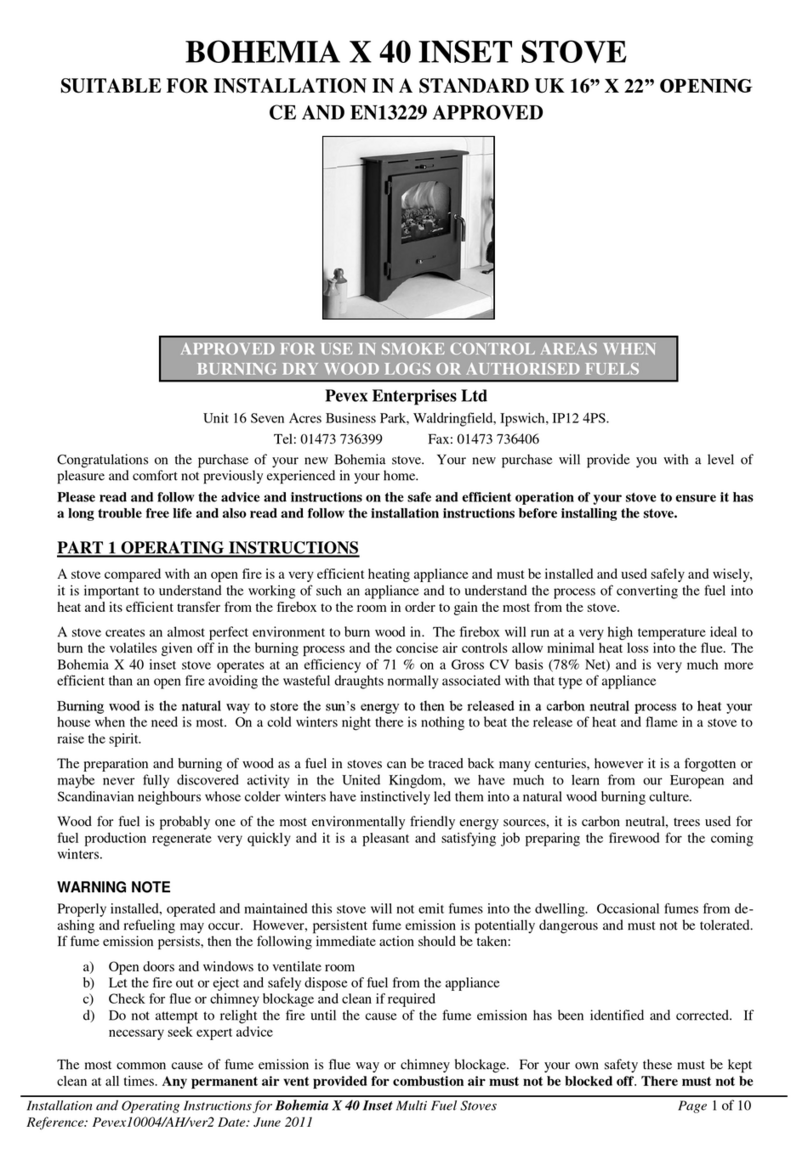
Pevex
Pevex BOHEMIA X 40 operating instructions

MonsterShop
MonsterShop Chimenea instruction manual

KVS EKODIVIZE
KVS EKODIVIZE KVS MORAVIA VSP-9106 Installation, operation and maintenance manual
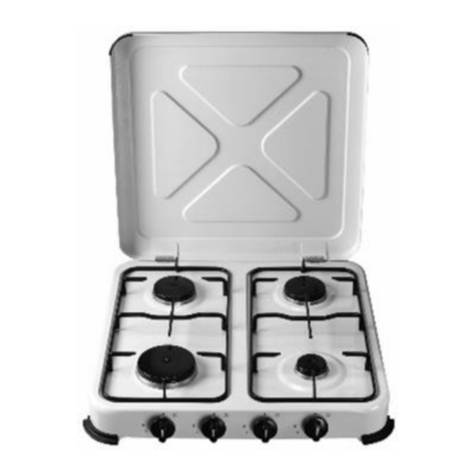
Kemper
Kemper 104980 Assembly instructions
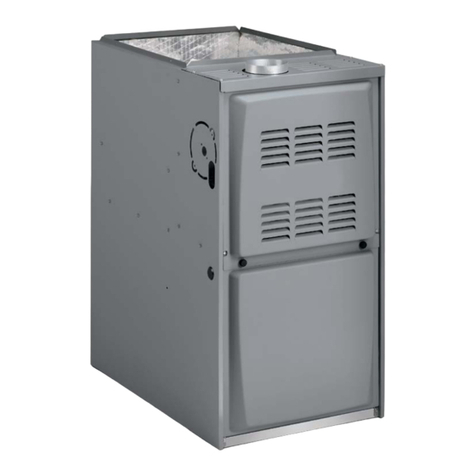
Allied
Allied A80UH1E Service manual
